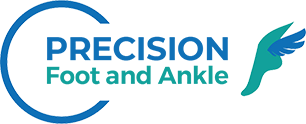The calf is made up of two muscles, the outer gastrocnemius muscle and the deeper soleus muscle. Both join together to form the Achilles tendon, which itself attached to the back of the heel bone. The calf is involved in standing, walking, running and walking. It is also essential to the structures lower down in the foot. A tight calf muscle can therefore affect the function of the ankle and foot both.
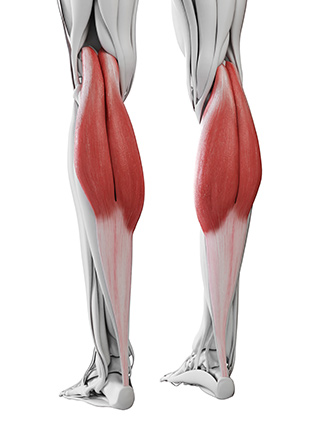
The diagram above shows the gastrocnemius muscle which attaches to the heel bone with the Achilles tendon.
What is a tight calf associated with?
- Heel pain caused by Achilles tendon disorders
- Sole of foot pain, related to a tight plantar fascia, causing plantar fasciitis
- Tibialis posterior tendon dysfunction causing a flat foot
- Forefoot pain such as Morton’s neuroma
Assessment
The tightness of the calf will be assessed by examining your ankle movement when the knee is kept straight and also when the knee is bent. The change in the position of the knee affects the length of the underlying gastrocnemius muscle. This is known as the Silfverskiöld test. When the knee is straight, the ankle should be able to bend toward the shin bone as shown below.
Treatment
The first stage of treating calf tightness is a sustained course of physiotherapy. These exercises should be performed daily, at least twice a day. It will take 8-12 weeks for any changes to occur. Your progress and technique will be monitored by a physiotherapist. The key exercises I would recommend for stretching the Achilles tendon are outlined here
Other conservative measures:
Slant board
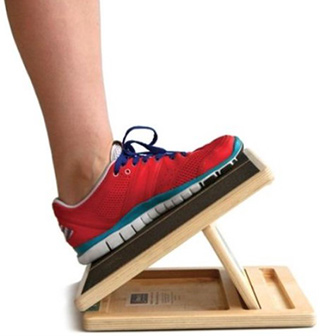
A slant board can be purchased online; examples are shown above. The slope of the board can be altered from a gentle to a steep incline. This stretch will allow you to control the tension in your calf muscles without overstraining them. The steepness of the board can be gradually increased as you become more comfortable. Make sure your feet are placing forward and parallel to each other. Lean your body forward, keeping it straight. Perform this exercise 3 times a day, holding for 3 minutes each time.
Night splint and Strassburg sock
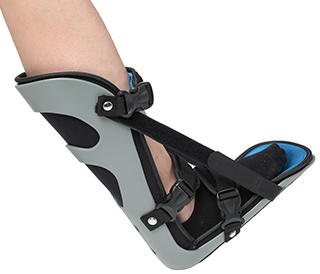
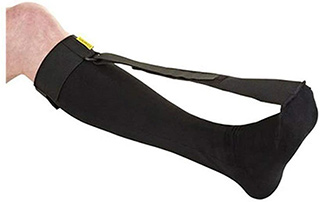
These can be put on at night and the strapping adjusted in order to create further stretch of the calf. It will take several weeks before any beneficial effects will be felt.
Surgery
Should the non-operative measures described above not work, then surgery may be recommended. The calf muscle can be released near the back of the knee, with a procedure known as ‘proximal medial gastrocnemius release’ or lower down toward the Achilles tendon.
Before surgery
Your fitness for surgery and your foot and ankle symptoms will be reassessed in our pre-assessment clinic, which usually takes place prior to the date of operation. Blood tests and further investigations of the heart and lungs may be required to ensure you are fit to have a general anaesthetic. If you live alone, we will liaise with your GP and social services to ensure that care is in place to look after you following surgery. Occasionally, you may need to spend a few extra days in hospital whilst the services are being organised.
We kindly ask that you contact us if you suffer an insect bite, cut or bruise to the symptomatic foot in the period leading up to your surgery, or if you have been unwell. Any injury to the skin in the area of your intended surgery can increase the risk of infection. You may need reassessment and surgery reorganised for another time.
On the day of the surgery
You will be seen before surgery by Mr Davda or a team member to check your consent and mark the leg. Calf release surgery is typically performed under general anaesthetic, which can be discussed with your anaesthetist. Occasionally, the surgery is performed with local anaesthetic and some sedation provided. The operation is performed as a day case procedure and you will be able to go home the same day.
The operation
The operation is performed with the patient lying on their front. This allows the back of the calf to be prepared thoroughly. A small incision about an inch long is made just below the knee joint crease. The tissue overlying the gastrocnemius muscle is incised and released so that the muscle below can stretch fully and lengthen. Local anaesthetic with adrenaline is injected into the area to provide pain relief and minimise bleeding. The procedure takes approximately 20 – 30 minutes. An adhesive dressing will be applied and then covered with a thicker wool bandage.

The photo above shows the typical position of the scar when performing calf release surgery. The patient lies on their front, and the back of the knee is prepared and draped for surgery here. A small incision is made on the inner aspect of the calf muscle.
Postoperative instructions
You will be able to put full weight through the leg. A walking aid may be provided on the ward if you are having difficulty walking initially. The incision site will be sore, hence painkillers are advised for the first week following the operation. The outer wool bandage can be removed by yourself after 2 days, but the adhesive dressing underneath should be kept clean and dry. This can then be removed by yourself after two weeks. An appointment with your local GP practice or hospital clinic may be organised to ensure your wound has healed. The stitches used to close the skin are normally dissolvable and will not need to be removed. Once the scar has healed you can massage the area with any form of moisturiser.
Exercises following surgery
Allow the first week following for surgery for the scar and soreness to settle. You can then begin non-weight bearing stretching exercises:
With your operated leg resting on a bed or sofa, place your knee as straight as possible. Roll a towel around the sole of your foot and pull up on the towel, like reigns on a horse. This will stretch the calf muscle to a comfortable point, but with no pain.

Pull and hold for 30 seconds and repeat 4-6 times. Aim to repeat this 3 times a day.
You can begin to progress to the stretching exercises
Complications
Bruising and swelling
This is common after surgery and may involve the whole calf
Tendon injury
The hamstring tendons are found close to the calf muscle. This can be injured at the time of surgery. This is an extremely rare occurrence.
Nerve damage
Small nerves that supply the skin can occasionally be bruised from surgery, leaving patches of numbness around the front or back of the knee. This usually resolves in the first 3-6 months.
Deep Vein Thrombosis (DVT)
This is a blood clot in the leg and occurs after surgery in about 1 in 100 patients. You can help prevent a blood clot by keeping your knee, ankle and toes moving following surgery. Keeping yourself hydrated is also helpful to prevent a DVT. Finally elevating your leg to the level of your heart will minimise the amount of swelling you have which will also help to prevent DVT.
Common Questions
When can I drive?
Driving is permitted about a week after surgery. You are advised to contact your insurance company to ensure you are covered to drive.
When can I go back to work?
This will depend on the type of work you do. For example, if you have a desk job you may be able to return to work in 1-2 weeks provided you are able to rest and elevate your foot whilst sitting. If you do a physically demanding job, you will need 3-4 weeks off.
When can I return to sport?
You can usually return to sport 6 weeks from the date of surgery. Recreational walking or light sporting activity can be resumed earlier, once the wound has healed.
